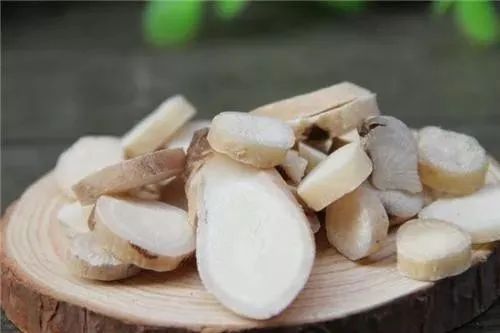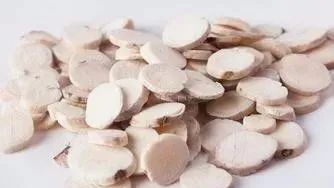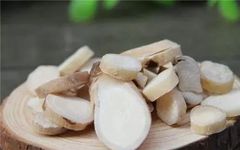The Complete Collection of Old Remedies to Promote Health Knowledge
Click below to follow for free↓↓↓

Bai Shao (White Peony)
Bai Shao (White Peony)
【Alias】 Bai Shao Yao, Shao Yao, Jin Shao Yao, Li Cao Gen, Ke Gao Gen, Jiang Gao Gen, Tian Dou, Yu Dou, Tian Kui, Yu Kui, Guan Fang, etc.
【Properties and Channels】 Bitter, sour; slightly cold; enters the Liver and Spleen meridians.
【Modern Research】 Bai Shao contains paeoniflorin, paeonol, paeoniflorin, paeonolide, benzoic acid, volatile oil, fatty oil, resin sugar, starch, mucilage, protein, and triterpenoid components. Pharmacological studies indicate that Bai Shao has effects such as regulating immunity, relieving spasms, sedating, analgesic, anticonvulsant, lowering blood pressure, dilating blood vessels, anti-inflammatory, and antibacterial properties.
【How to Choose】 When selecting Bai Shao, choose roots that are thick, long, uniform, straight, with a smooth skin color, firm texture, a powdery white cross-section, and no white heart or fractures.
【Effects and Characteristics】
Bai Shao is a commonly used blood-nourishing herb. Traditional Chinese Medicine (TCM) believes that blood has nourishing and moistening functions. If there is blood deficiency, it cannot nourish the face, resulting in a pale, sallow complexion without luster, pale lips and nails, dizziness, and blurred vision; if blood does not nourish the heart, it manifests as palpitations, insomnia, and vivid dreams; blood deficiency cannot fill the uterus, leading to irregular menstruation, scanty menstrual flow, and pale color in women; blood deficiency cannot nourish the skin, resulting in dry, rough skin and numbness in the hands and feet. Various anemia patients or those with physical weakness often exhibit these symptoms. In such cases, Bai Shao can be used in combination with other blood-nourishing herbs such as Shu Di Huang (Rehmannia), Dang Gui (Angelica), E Jiao (Donkey-hide Gelatin), and Long Yan Rou (Longan). The usual method of preparation is decoction with water, with a dosage of 5-15 grams, and a larger dosage of 15-30 grams. According to the TCM principle of “Eighteen Contradictions,” Bai Shao should not be used with Li Lu (Veratrum).

Bai Shao (White Peony)
【Proven Formulas】
Si Wu Tang (Four Substance Decoction): Shu Di Huang 12g, Dang Gui 9g, Bai Shao 9g, Chuan Xiong 6g. Decoction in water, for blood nourishment. It is used to treat blood deficiency with a dull complexion, pale lips and nails, dizziness, palpitations, insomnia, various types of anemia, and irregular menstruation.
Bu Gan Tang (Liver Nourishing Decoction): Dang Gui, Sheng Di, Shao Yao, Chuan Xiong, Suan Zao Ren, Mu Guo each 9g, Gan Cao 3g, decocted in water, nourishes blood, softens the liver, invigorates blood, regulates menstruation, and treats liver blood deficiency, dizziness, scanty menstrual flow, and numbness in the limbs.
【Available Patent Medicines】
Sheng Xue Bao Granules: Nourishes the liver and kidneys, benefits Qi and generates blood, used for fatigue, weakness in the waist and knees, dizziness, tinnitus, palpitations, shortness of breath, insomnia, dry throat, and poor appetite due to liver and kidney deficiency, and Qi and blood deficiency; for iron deficiency anemia with the above symptoms.
【Classic Medicinal Cuisine】
Bai Shao and Chuan Xiong Stewed Fish Head: Bai Shao, Chuan Xiong each 10g, Gan Cao 6g, one carp head, appropriate amounts of cooking wine, ginger, scallions, and salt. Bai Shao, Gan Cao, and Chuan Xiong are sliced thinly; the carp head is cleaned and gills removed; ginger is sliced, and scallions are cut into sections. The fish head is rubbed with cooking wine and salt, placed in a stewing pot, along with Bai Shao, Gan Cao, and Chuan Xiong, and 800ml of water is added, along with ginger slices and scallion sections. The pot is placed on high heat until boiling, then simmered on low heat for 20 minutes. Consume once daily, with 50-100g of fish head each time, to promote Qi, nourish blood, and relieve pain.
The Home of Folk Remedies to Promote Health Knowledge
Click below to follow for free↓↓↓
The Editor Shares Good Articles with Friends
1.Can San Qi Powder be Eaten Regularly? Be Aware of These 10 Side Effects Before Deciding!
2. Side Effects of San Qi Powder: Eating San Qi This Way Can Be Dangerous!
3. So Precious! Over 800 Folk Remedies, No Illness Cannot Be Treated, Save for Future Use!
4. The Most Comprehensive Collection of Tuina Techniques Videos—Hurry Up and Save if You Want to Learn Tuina Massage!
Like is a form of encouragement Share to spread joy

